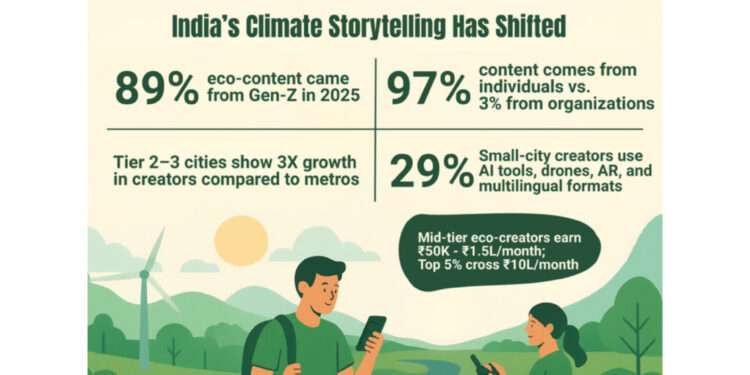Regional creators from Tier 2–3 cities lead India’s digital climate movement, with fastest growth recorded in Indore, Jaipur, Kochi, Bhubaneswar, and Chandigarh.
National, August 27, 2025: India’s digital climate conversation is being reshaped by its youngest citizens. According to a new report by WeNaturalists—a global platform for nature professionals and enthusiasts with over 500,000 members—Gen Z creators (aged 13–27) contributed 89% of all eco-content in 2024, while nature-related posts surged by 34% compared to 2023.
This growth is being fueled primarily by creators from Tier 2 and Tier 3 cities, which now produce three times more new eco-creators than metros. Among the fastest-growing hubs are Indore, Jaipur, Kochi, Bhubaneswar, and Chandigarh. These creators are spotlighting hyperlocal issues such as Delhi’s air pollution, Rajasthan’s water crises, deforestation in the Northeast, and coastal resilience in Tamil Nadu and Kerala, making the climate movement more participative and action-oriented.
From 2021 to 2024, nature-related content creation on the platform increased steadily by 34%. By August 2025, WeNaturalists had already recorded 80% of last year’s total post volume, signaling another record-breaking year. Notably, 97% of content continues to come from individual voices, underlining the grassroots and youth-driven nature of the movement.
“The consistency of growth in climate content and the fact that nearly 97% is being driven by individual voices tells us one thing clearly: young creators, especially from India’s non-metro cities, are not just speaking up, they’re stepping up,” said Amit Banka, Founder & CEO of WeNaturalists. “Our priority now is to strengthen this movement with digital tools, community-building opportunities, and innovative monetization models to empower creators.”
The wider digital ecosystem is also witnessing a green shift. Instagram, YouTube, LinkedIn, and X remain the top platforms for eco and sustainability content, while Facebook continues to drive community-led mobilization. User-generated content has proven especially powerful, delivering four times more engagement than branded posts.
Spikes in climate-related conversations are strongly tied to global events. In 2025, World Earth Day posts grew by 95% over 2024, World Environment Day content nearly doubled (from 782 posts in 2023 to 1,528 in 2025), and World Nature Conservation Day posts rose 6.8%.
Technology adoption is shaping the future of the green creator economy. In 2025, about 29% of Tier 2–3 creators used AI for editing, scripting, or optimization, while drones, AR filters, and multilingual content formats boosted engagement. Monetization is also accelerating—mid-tier creators are now earning ₹50,000–₹1.5 lakh per month, with top 5% crossing ₹10 lakh through partnerships and campaigns. Even micro-influencers are gaining traction due to high engagement on storytelling-led content.
With India expected to play a defining role in global climate discourse, WeNaturalists predicts record participation in the eco-creator economy in 2025–26. The movement, led by young voices from regional India, is increasingly digital, local, and impact-driven.
About WeNaturalists:
WeNaturalists is a global digital platform connecting nature professionals, enthusiasts, and organizations to scale climate action and advance the UN’s Sustainable Development Goals (SDGs). With over 500,000 members, the platform enables networking, project management, storytelling, and monetization opportunities for creators, NGOs, and businesses focused on environmental sustainability.






























